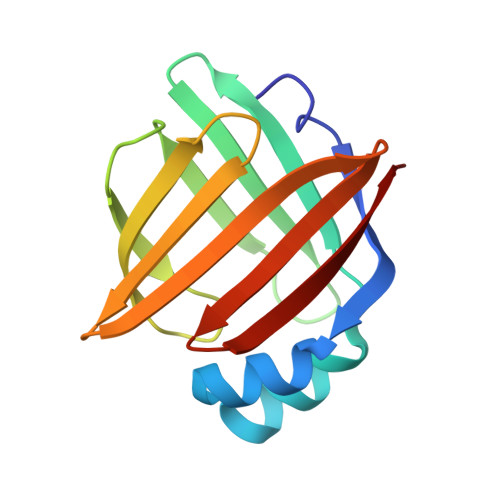Crystal structure and thermodynamic analysis of human brain fatty acid-binding protein.
Balendiran, G.K., Schnutgen, F., Scapin, G., Borchers, T., Xhong, N., Lim, K., Godbout, R., Spener, F., Sacchettini, J.C.(2000) J Biological Chem 275: 27045-27054
- PubMed: 10854433
- DOI: https://doi.org/10.1074/jbc.M003001200
- Primary Citation of Related Structures:
1FDQ, 1FE3 - PubMed Abstract:
Expression of brain fatty acid-binding protein (B-FABP) is spatially and temporally correlated with neuronal differentiation during brain development. Isothermal titration calorimetry demonstrates that recombinant human B-FABP clearly exhibits high affinity for the polyunsaturated n-3 fatty acids alpha-linolenic acid, eicosapentaenoic acid, docosahexaenoic acid, and for monounsaturated n-9 oleic acid (K(d) from 28 to 53 nm) over polyunsaturated n-6 fatty acids, linoleic acid, and arachidonic acid (K(d) from 115 to 206 nm). B-FABP has low binding affinity for saturated long chain fatty acids. The three-dimensional structure of recombinant human B-FABP in complex with oleic acid shows that the oleic acid hydrocarbon tail assumes a "U-shaped" conformation, whereas in the complex with docosahexaenoic acid the hydrocarbon tail adopts a helical conformation. A comparison of the three-dimensional structures and binding properties of human B-FABP with other homologous FABPs, indicates that the binding specificity is in part the result of nonconserved amino acid Phe(104), which interacts with double bonds present in the lipid hydrocarbon tail. In this context, analysis of the primary and tertiary structures of human B-FABP provides a rationale for its high affinity and specificity for polyunsaturated fatty acids. The expression of B-FABP in glial cells and its high affinity for docosahexaenoic acid, which is known to be an important component of neuronal membranes, points toward a role for B-FABP in supplying brain abundant fatty acids to the developing neuron.
- Department of Biochemistry & Biophysics, Texas A&M University, College Station, Texas 77843-2128, USA. balendra@reddrum.tamu.edu
Organizational Affiliation:

















